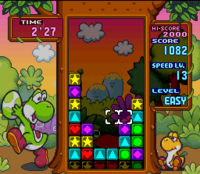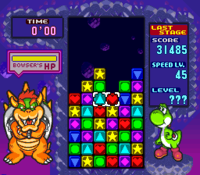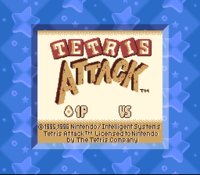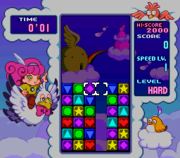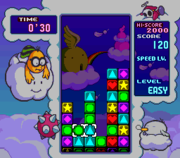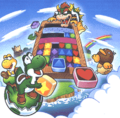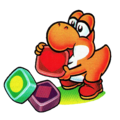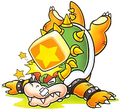Tetris Attack: Difference between revisions
No edit summary |
Tag: Rollback |
||
| (42 intermediate revisions by 17 users not shown) | |||
| Line 1: | Line 1: | ||
{{italic title}} | {{italic title}} | ||
{{ | {{game infobox | ||
|image=[[File:TAT.jpg|250px]]<br>SNES box art<br>[[File:TA GameBoyCover.jpg|250px]]<br>Game Boy box art | |image=[[File:TAT.jpg|250px]]<br>SNES box art<br>[[File:TA GameBoyCover.jpg|250px]]<br>Game Boy box art | ||
|developer=[[Intelligent Systems]]<br>[[Nintendo R&D1]] ([[Game Boy]] version) | |developer=[[Intelligent Systems]]<br>[[Nintendo R&D1]] ([[Game Boy]] version) | ||
|publisher=[[Nintendo]] | |publisher=[[Nintendo]] | ||
| | |release='''SNES/Game Boy:'''<br>{{release|USA|August 1996|Japan|October 26, 1996 (Game Boy only)|Europe|November 28, 1996|Australia|1996<ref>[http://www.themushroomkingdom.net/games/ta-snes Date info of Tetris Attack (SNES) from TMK], retrieved 4/1/2008</ref>{{better source}}}} '''Satellaview:'''<br>{{release|Japan|November 3, 1996}} '''Virtual Console (3DS):'''<br>{{release|Japan|December 11, 2013}} | ||
|genre=[[Genre#Puzzle|Puzzle]] | |genre=[[Genre#Puzzle|Puzzle]] | ||
|modes=Single-player, multiplayer | |modes=Single-player, multiplayer | ||
| Line 12: | Line 12: | ||
|input={{input|snes=1|gb=1|3ds=1}} | |input={{input|snes=1|gb=1|3ds=1}} | ||
}} | }} | ||
'''''Tetris Attack''''' is a [[Super Nintendo Entertainment System]] and [[Game Boy]] [[Genre#Puzzle|puzzle]] game featuring the [[Yoshi (franchise)|''Yoshi'' franchise]] as a theme by altering graphics and audio of the Japanese game ''[[#Panel de Pon|Panel de Pon]]''. Despite its name, ''Tetris Attack'' has no relation to the ''[[harddrop:Tetris|Tetris]]'' series, and follow-ups were named ''Puzzle League'' in the west starting with ''[[bulbapedia:Pokémon Puzzle League|Pokémon Puzzle League]]''. | '''''Tetris Attack''''' is a [[Super Nintendo Entertainment System]] and [[Game Boy]] [[Genre#Puzzle|puzzle]] game featuring the [[Yoshi (franchise)|''Yoshi'' franchise]] as a theme by altering graphics and audio of the Japanese game ''[[#Panel de Pon|Panel de Pon]]''. Despite its name, ''Tetris Attack'' has no relation to the ''[[harddrop:Tetris|Tetris]]'' series, and follow-ups were named ''Puzzle League'' in the west starting with ''[[bulbapedia:Pokémon Puzzle League|Pokémon Puzzle League]]''. The Japanese version of ''Tetris Attack'' was released on the [[Satellaview]] as a ''[[Yoshi (franchise)|Yoshi]]'' title instead of using the ''Tetris'' name license. Like ''Tetris Attack'', there was an option in the menus to play the game with the characters and story dialogue in English, but the menus would stay in Japanese. The [[Game Boy]] version was also released in Japan as a standard cartridge. | ||
==Gameplay== | ==Gameplay== | ||
{{multiframe | {{multiframe | ||
| Line 28: | Line 27: | ||
==Single-player mode== | ==Single-player mode== | ||
===Endless=== | ===Endless=== | ||
[[File:TA LittleYoshi.png|thumb|left|[[Yoshi]] and [[Baby Yoshi]] in ''Tetris Attack''.]] | [[File:TA LittleYoshi.png|thumb|left|[[Yoshi]] and [[Baby Yoshi|Little Yoshi]] in ''Tetris Attack''.]] | ||
In Endless mode, players play to try to achieve the best possible score before they get a game over. Players can choose the difficulty level (Easy, Normal, Hard) and the speed level (lv. 1-99) to start out. However, the longer they manage to stay alive, the faster the stack will start to rise. If the player manages to reach a score of 99,999, the credits sequence will play. | In Endless mode, players play to try to achieve the best possible score before they get a game over. Players can choose the difficulty level (Easy, Normal, Hard) and the speed level (lv. 1-99) to start out. However, the longer they manage to stay alive, the faster the stack will start to rise. If the player manages to reach a score of 99,999, the credits sequence will play. | ||
{{br|left}} | {{br|left}} | ||
| Line 45: | Line 44: | ||
===Puzzle=== | ===Puzzle=== | ||
In the puzzle mode, players are given a number of panels on the screen, and they must clear all of them with only a limited number of switches by the cursor. Players play ten rounds with up to six different characters. Also, at the end of each round, players are given a password, which they can use to come back to their game at a later time. There is no time limit for this game mode. | In the puzzle mode, players are given a number of panels on the screen, and they must clear all of them with only a limited number of switches by the cursor. Players play ten rounds with up to six different characters. Also, at the end of each round, players are given a password, which they can use to come back to their game at a later time. There is no time limit for this game mode. There are also some even more difficult puzzles that players can play with if they have the proper password. | ||
===VS=== | ===VS.=== | ||
[[File:TA Shock Panel.png|thumb]] | |||
[[File:TA Shock Panel.png|thumb | Single player VS. is a game where players can battle the computer in a fight to free the players' allies from a spell cast by [[Kamek]]. One by one, the players and [[Yoshi]] must break the spell over each of their allies by battling and defeating them. The key to doing that is to dump [[garbage block]]s, which resemble the ceiling from ''[[Wario's Woods]]'', on their stack. There are special panels called [[Shock Panel]]s. When three or more of these align, this creates a [[Shock Block]], a special garbage block, which makes clearing garbage blocks more difficult. Each battle gets successively more difficult, and as the players progress and free their allies, they can use them in battle as well. | ||
Single player VS is a game where players can battle the computer in a fight to free the players' allies from a spell cast by [[Kamek]]. One by one, the players and [[Yoshi]] must break the spell over each of their allies by battling and defeating them. The key to doing that is to dump [[garbage block]]s, which resemble the ceiling from ''[[Wario's Woods]]'', on their stack. There are special panels called [[Shock Panel]]s. When three or more of these align, this creates a [[Shock Block]], a special garbage block, which makes clearing garbage blocks more difficult. Each battle gets successively more difficult, and as the players progress and free their allies, they can use them in battle as well. | |||
Inside Mt. Wickedness, the players will face off against [[Hookbill the Koopa]] and [[Naval Piranha]] on all the skill levels. On the "Normal" and "Hard" skill levels, Kamek will be the next opponent. And on the "Hard" skill level, the players will face Bowser as the final opponent. | Inside Mt. Wickedness, the players will face off against [[Hookbill the Koopa]] and [[Naval Piranha]] on all the skill levels. On the "Normal" and "Hard" skill levels, Kamek will be the next opponent. And on the "Hard" skill level, the players will face Bowser as the final opponent. | ||
| Line 69: | Line 65: | ||
*[[Gargantua Blargg]] | *[[Gargantua Blargg]] | ||
*[[Raphael the Raven|Raphael The Raven]] | *[[Raphael the Raven|Raphael The Raven]] | ||
The following characters can only be used in the VS game modes. There is an exception in the Game Boy version of the Puzzle game mode. | The following characters can only be used in the VS game modes. There is an exception in the Game Boy version of the Puzzle game mode. | ||
*[[Bumpty]] (SNES version only) | *[[Bumpty]] (SNES version only) | ||
| Line 80: | Line 75: | ||
*[[Kamek]] | *[[Kamek]] | ||
*[[Bowser]] | *[[Bowser]] | ||
Note: All rival characters can only be used in the 2P Mode. There is an exception in the Game Boy version of the Puzzle game mode, however. | Note: All rival characters can only be used in the 2P Mode. There is an exception in the Game Boy version of the Puzzle game mode, however. | ||
==Secrets== | ==Secrets== | ||
Below are a list of secrets that can be found. None of them stay unlocked, however. | Below are a list of secrets that can be found. None of them stay unlocked, however. | ||
===SNES=== | ===SNES=== | ||
#Upon turning on the SNES, press the following buttons; {{button|snes|B}}, {{button|snes|A}}, {{button|L}}, {{button|L}}. If done correctly, the player will hear a chime. When the player does a one-player game mode, the stack will not stop, regardless of if the player does a combo or chain. | #Upon turning on the SNES, press the following buttons; {{button|snes|B}}, {{button|snes|A}}, {{button|L}}, {{button|L}}. If done correctly, the player will hear a chime. When the player does a one-player game mode, the stack will not stop, regardless of if the player does a combo or chain. | ||
| Line 92: | Line 85: | ||
===Super Game Boy=== | ===Super Game Boy=== | ||
[[File:TASGB.PNG|thumb | [[File:TASGB.PNG|thumb|Default border.]] | ||
When the Game Boy version is played on a [[Super Game Boy]], certain button codes, if "1P" is selected at the title screen, trigger six secret borders, which are based on the background designs used for Yoshi's and his pals' stages in the SNES version. The borders and their corresponding codes are as follows: | When the Game Boy version is played on a [[Super Game Boy]], certain button codes, if "1P" is selected at the title screen, trigger six secret borders, which are based on the background designs used for Yoshi's and his pals' stages in the SNES version. The borders and their corresponding codes are as follows: | ||
{|class="wikitable" | |||
{| class="wikitable" | |||
! | ! | ||
!{{button|Paddown}} | !{{button|Paddown}} | ||
| Line 120: | Line 112: | ||
==''Panel de Pon''== | ==''Panel de Pon''== | ||
{{ | {{game infobox | ||
|title=Panel de Pon | |title=Panel de Pon | ||
|image=[[File:PaneldePon SuperFamicomBox.jpg|200px]] | |image=[[File:PaneldePon SuperFamicomBox.jpg|200px]] | ||
| Line 126: | Line 118: | ||
|publisher=[[Nintendo]] | |publisher=[[Nintendo]] | ||
|platforms=[[Super Nintendo Entertainment System|Super Famicom]], [[Virtual Console]] ([[Wii]], [[Wii U]], [[Nintendo 3DS#New Nintendo 3DS/New Nintendo 3DS XL|New Nintendo 3DS]]), [[Classics#Nintendo Classic Mini: Super Famicom|Nintendo Classic Mini: Super Famicom]], [[Super Nintendo Entertainment System - Nintendo Switch Online]] | |platforms=[[Super Nintendo Entertainment System|Super Famicom]], [[Virtual Console]] ([[Wii]], [[Wii U]], [[Nintendo 3DS#New Nintendo 3DS/New Nintendo 3DS XL|New Nintendo 3DS]]), [[Classics#Nintendo Classic Mini: Super Famicom|Nintendo Classic Mini: Super Famicom]], [[Super Nintendo Entertainment System - Nintendo Switch Online]] | ||
| | |release='''Super Famicom:'''<br>{{release|Japan|October 27, 1995}} '''Virtual Console (Wii):'''<br>{{release|Japan|November 27, 2007|South Korea|September 30, 2008<ref>http://www.nintendo.co.kr/Wii/wii/vconsol/penullopong/penullopong_01.php</ref>}} '''Virtual Console (Wii U):'''<br>{{release|Japan|May 29, 2013}} '''Virtual Console (New Nintendo 3DS):'''<br>{{release|Japan|August 9, 2016}} '''Nintendo Classic Mini: Super Famicom:'''<br>{{release|Japan|October 5, 2017}} '''Super Nintendo Entertainment System - Nintendo Switch Online:'''<br>{{release|Japan|May 20, 2020<ref>Nintendo 公式チャンネル (May 14, 2020). [https://youtu.be/ndsH1j5wuAI ファミリーコンピュータ & スーパーファミコン Nintendo Switch Online 追加タイトル <nowiki>[2020年5月]</nowiki>]. ''YouTube''. Retrieved May 14, 2020.</ref>|USA|May 20, 2020<ref>Nintendo (May 14, 2020). [https://youtu.be/Fq7D2Rpc9jg NES & Super NES - May Game Updates - Nintendo Switch Online]. ''YouTube''. Retrieved May 14, 2020.</ref>|Europe|May 20, 2020<ref>@NintendoEurope (May 15, 2020). [https://twitter.com/NintendoEurope/status/1261219840892833792?s=20 ''"More #NES and #SuperNES games will arrive on 20/05 for #NintendoSwitchOnline members!"''] ''Twitter''. Retrieved May 15, 2020.</ref>|Australia|May 20, 2020<ref>@NintendoAUNZ (May 20, 2020). [https://twitter.com/NintendoAUNZ/status/1263016678251810822?s=20 ''"More #NES and #SuperNES games have arrived for #NintendoSwitchOnline members!"''] ''Twitter''. Retrieved May 20, 2020.</ref>|HK|May 20, 2020|South Korea|May 20, 2020}} | ||
|genre=[[Genre#Puzzle|Puzzle]] | |genre=[[Genre#Puzzle|Puzzle]] | ||
|ratings={{ratings|cero=A}} | |ratings={{ratings|cero=A}} | ||
|modes=Single-player, multiplayer | |modes=Single-player, multiplayer | ||
|media={{media|snes=1|wiidl=1|wiiudl=1|3dsdl=1|snesclassic=1| | |media={{media|snes=1|wiidl=1|wiiudl=1|3dsdl=1|snesclassic=1|switchdl=1}} | ||
|input={{input|snes=1|classic=1|wiigcn=1|wiiu=1|wiiuclassic=1|wiiupro=1|3ds=1|snesclassic=1|joy-con=1| | |input={{input|snes=1|classic=1|wiigcn=1|wiiu=1|wiiuclassic=1|wiiupro=1|3ds=1|snesclassic=1|joy-con=1|switchpro=1|switchsnes=1}} | ||
}} | }} | ||
{{multiple image | {{multiple image | ||
| Line 141: | Line 133: | ||
|image2=TA Lakitu Stage.png | |image2=TA Lakitu Stage.png | ||
}} | }} | ||
Originally, ''Tetris Attack'' was '''''Panel de Pon''''', released for the [[Super Nintendo Entertainment System|Super Famicom]] on October 27, 1995, starring a young fairy known as Lip. However, the game did not initially release in other countries as-is. For the international releases, [[Nintendo]] changed all the characters to ''[[Yoshi (franchise)|Yoshi]]'' [[List of characters|characters]] and [[List of enemies|enemies]] and renamed it | Originally, ''Tetris Attack'' was '''''Panel de Pon''''', released for the [[Super Nintendo Entertainment System|Super Famicom]] on October 27, 1995, starring a young fairy known as Lip. However, the game did not initially release in other countries as-is. For the international releases, [[Nintendo]] changed all the characters to ''[[Yoshi (franchise)|Yoshi]]'' [[List of characters|characters]] and [[List of enemies|enemies]] and renamed it.<ref>[http://themushroomkingdom.net/ta_pdp.shtml Panel de Pon and Tetris Attack Comparison] at The Mushroom Kingdom</ref> | ||
{{br|left}} | {{br|left}} | ||
=== | ===Differences=== | ||
====Character replacements==== | |||
{|class="wikitable"style="text-align: center" | |||
|- | |||
The | !VS. mode stage | ||
!''Panel de Pon'' | |||
!''Tetris Attack'' | |||
|- | |||
|Start Point | |||
|Lip | |||
|Yoshi | |||
|- | |||
|Stage 1 | |||
|Windy | |||
|Lakitu | |||
|- | |||
|Stage 2 | |||
|Sharbet | |||
|Bumpty | |||
|- | |||
|Stage 3 | |||
|Thiana | |||
|Poochy | |||
|- | |||
|Stage 4 | |||
|Ruby | |||
|Flying Wiggler | |||
|- | |||
|Stage 5 | |||
|Elias | |||
|Froggy | |||
|- | |||
|Stage 6 | |||
|Flare | |||
|Gargantua Blargg | |||
|- | |||
|Stage 7 | |||
|Neris | |||
|Lunge Fish | |||
|- | |||
|Stage 8 | |||
|Seren | |||
|Raphael The Raven | |||
|- | |||
|Stage 9 | |||
|Phoenix | |||
|Hookbill The Koopa | |||
|- | |||
|Stage 10 | |||
|Dragon | |||
|Naval Piranha | |||
|- | |||
|Stage 11 | |||
|Sanatos | |||
|Kamek | |||
|- | |||
|Stage 12 | |||
|Corderia | |||
|Bowser | |||
|} | |||
''[[ | ====Graphics==== | ||
*The title sequences are completely different. ''Panel de Pon'' has Lip hanging from a dandelion over a field of pink and orange flowers. ''Tetris Attack'' has Yoshi sitting on a large flower holding an eggshell with [[panel]]s in it surrounded by Little Yoshis on smaller flowers, while the background is a jungle area with blue hills similar to the ones seen on the title screen of ''[[Super Mario World 2: Yoshi's Island]]''. | |||
*On the main menu in ''Panel de Pon'', Lip is shown sitting on a flower. In ''Tetris Attack'', Yoshi is instead sitting in a floating eggshell, along with Little Yoshi. | |||
*In ''Panel de Pon'', garbage blocks have a different design for each character. In ''Tetris Attack'', all garbage blocks look the same aside from their color; the first player's blocks are blue, while the second player's are red. | |||
*In the character selection screen for 2-player mode, the characters' names shown beneath their icons in ''Panel de Pon'' were removed in ''Tetris Attack'' due to some of the replacement characters' names being too long to fit there. | |||
*Lip's flower-themed stage was completely redesigned for Yoshi, now taking place on [[Yoshi's Island (location)|Yoshi's Island]]. Only the tree that serves as the border for the playing field was left intact, though the leaves are a lighter shade of green and the flowers were removed. | |||
*In Stage Clear, Bowser replaces Sanatos for the "special stage" and "last stage". | |||
*Stage 4 of VS. Mode was changed from a jewel-themed stage (for Ruby) to a flower themed-one (for Flying Wiggler) with graphics resembling tiles seen in certain levels from ''Super Mario World 2: Yoshi's Island'', such as [[Visit Koopa and Para-Koopa]]. | |||
*Stages 9, 10, and 11 have unique graphics in ''Panel de Pon''. In ''Tetris Attack'', all three stages use the same background as the cutscenes in Mt. Wickedness. | |||
*Bowser's stage (Stage 12) is an altered version of the Dragon's stage (Stage 10) in ''Panel de Pon'', primarily altering the stone face in the middle to resemble Bowser instead of a dragon. | |||
*The [[Game Over]] screens in VS. mode are entirely different. ''Panel de Pon'' shows Lip sulking on a plain blue background next to an image of the opponent she lost to, with the words "GAME OVER" in a plain red font inside a speech bubble. ''Tetris Attack'' has Yoshi lying dazed on the floor in front of a gradient blue background with the words "GAME OVER" displayed above him in a much larger and more colorful and stylized font. | |||
====Audio==== | |||
*All voice clips were changed to accommodate the character replacements. | |||
*''Tetris Attack'' replaces the title theme from ''Panel de Pon'' with an arrangement of the title theme from ''Super Mario World 2: Yoshi's Island''. | |||
*Yoshi's stage theme is an arrangement of the intro story theme from ''Super Mario World 2: Yoshi's Island'', replacing Lip's theme. Lip's theme still plays during the game's tutorials. | |||
*''Tetris Attack'' has victory and loss themes in VS. mode and 2-player mode, while in ''Panel de Pon'', the stage's "panic" theme continues to play even after the match ends. 2-player matches and losses in VS. mode play the same theme that plays at the end of stages in other modes, while victories in VS. mode use a completely new theme. | |||
*''Panel de Pon'' has three Game Over themes, which are music box renditions of Lip's, Windy's, and Elias' themes (the tutorial theme, Lakitu's theme, and Froggy's theme in ''Tetris Attack''). ''Tetris Attack'' replaces all of them with a music box rendition of Yoshi's theme. | |||
*Kamek's stage (Stage 11) uses the background music from the Phoenix and Dragon stages, instead of Sanatos' background music, which was moved to Bowser's stage (Stage 12). | |||
*Corderia's background music is not used by any of the playable characters in ''Tetris Attack'', but it does play in the cutscene before the player faces Bowser in VS. mode. This change consequently results in Corderia's "panic" background music to go unused, and was removed altogether. | |||
'' | ====Miscellaneous==== | ||
*''Tetris Attack'' added a password system for VS. mode. | |||
*The options menu in ''Tetris Attack'' is not selectable through normal means in ''Panel de Pon'', but can be accessed via code devices or hacking.<ref>TCRF. [[tcrf:Tetris_Attack_(SNES)#Options_Menu|Tetris Attack (SNES)]]. ''The Cutting Room Floor''. Retrieved May 3, 2023.</ref> | |||
*After seeing the endings in ''Panel de Pon'', players have to reset the game to return to the title screen. In ''Tetris Attack'', players are taken back to the title screen after the endings are finished. | |||
'' | ===References in ''Super Mario''-related games=== | ||
In the [[Super Smash Bros. (series)|''Super Smash Bros.'' series]], [[Lip's Stick]], an item used by Lip, is an item throughout the series. [[Kirby]]'s [[Kirby#Stone|Stone]] move can turn him into many objects, including a garbage block from ''Panel de Pon''. ''Panel de Pon'' music also appears in ''[[Super Smash Bros. Brawl]]'', ''[[Super Smash Bros. for Wii U]]'', and ''[[Super Smash Bros. Ultimate]]''. The fairy Lip herself appears as an important character in ''[[Captain Rainbow]]''. She also appears as a spirit and [[Mii Swordfighter]] costume in ''Super Smash Bros. Ultimate''. | |||
===Re-releases=== | |||
''Panel de Pon'' was released on the [[Wii]]'s [[Virtual Console#Wii|Virtual Console]] on November 27, 2007<ref>http://www.nintendo.co.jp/wii/vc/vc_pa/</ref>, on the [[Wii U]]'s [[Virtual Console#Wii U|Virtual Console]] on May 29, 2013, and on the [[Nintendo 3DS#New Nintendo 3DS/New Nintendo 3DS XL|New Nintendo 3DS]]'s [[Virtual Console#Nintendo 3DS|Virtual Console]] on August 9, 2016, once again solely in Japan.<ref>http://www.nintendo.co.jp/wiiu/software/vc/ja3j/</ref> It is also one of the 21 games included in the [[Classics#Nintendo Classic Mini: Super Famicom|Nintendo Classic Mini: Super Famicom]] exclusive to Japan.<ref>Nintendo. (June 27, 2017). [https://topics.nintendo.co.jp/c/article/74fe7608-5638-11e7-8cda-063b7ac45a6d.html ファミコンに続いて、スーパーファミコンが小さくなって再登場!]. ''Nintendo''. Retrieved July 24, 2017.</ref> It was also released in Japan and for the first time overseas in the Americas, Europe, and Australia for the [[Super Nintendo Entertainment System - Nintendo Switch Online]] application on May 20, 2020. | |||
===Names in other languages=== | ===Names in other languages=== | ||
{{foreign names | {{foreign names | ||
|Jap=パネルでポン | |Jap=パネルでポン | ||
|JapR= | |JapR=Paneru de Pon | ||
|JapM= | |JapM=Popping Panel | ||
|Kor=패널로 퐁 | |Kor=패널로 퐁 | ||
|KorR=Paeneollo pong | |KorR=Paeneollo pong | ||
| Line 177: | Line 240: | ||
==Development== | ==Development== | ||
After the Japanese release of ''Panel de Pon'', Yasuhiro Minagawa, the head of PR at Nintendo of Japan, announced that [[Rare Ltd.|Rare]] was requested to release it overseas with the original fairies replaced by ''{{wp|Killer Instinct}}'' characters and sound effects.<ref>''Nintendo Magazine System'' (UK) #40, {{media link|NMS UK I40 P88.jpg|page 88}}.</ref> This plan for the western localization was ultimately rejected, but the game was later greenlit with a ''[[Mario (franchise)|Mario]]'' theme.<ref>''Nintendo Magazine System'' (UK) #42, {{media link|NMS UK I42 P8.jpg|page 8}}.</ref> | After the Japanese release of ''Panel de Pon'', Yasuhiro Minagawa, the head of PR at Nintendo of Japan, announced that [[Rare Ltd.|Rare]] was requested to release it overseas with the original fairies replaced by ''{{wp|Killer Instinct}}'' characters and sound effects.<ref>''Nintendo Magazine System'' (UK) #40, {{media link|NMS UK I40 P88.jpg|page 88}}.</ref> This plan for the western localization was ultimately rejected, but the game was later greenlit with a ''[[Super Mario (franchise)|Super Mario]]'' theme.<ref>''Nintendo Magazine System'' (UK) #42, {{media link|NMS UK I42 P8.jpg|page 8}}.</ref> | ||
==Reception== | ==Reception== | ||
| Line 184: | Line 247: | ||
==Staff== | ==Staff== | ||
{{main|List of Tetris Attack staff}} | {{main|List of Tetris Attack staff}} | ||
==Quotes== | |||
{{main|List of Tetris Attack quotes}} | |||
==Gallery== | ==Gallery== | ||
| Line 205: | Line 271: | ||
==Names in other languages== | ==Names in other languages== | ||
{{foreign names | {{foreign names | ||
|Jap=ヨッシーのパネポン<br>''Yosshī no Panepon''<br>ヨッシーのパネポンBS版<br>''Yosshī no Panepon BS- | |Jap=ヨッシーのパネポン<br>''Yosshī no Panepon''<br>ヨッシーのパネポンBS版<br>''Yosshī no Panepon BS-ban'' | ||
|JapM=''Yoshi's PanePon''<br>(Game Boy)<br>''Yoshi's PanePon BS Edition''<br>(Satellaview)}} | |JapM=''Yoshi's PanePon''<br>(Game Boy)<br>''Yoshi's PanePon BS Edition''<br>(Satellaview) | ||
}} | |||
==Trivia== | ==Trivia== | ||
*Lip's | *In ''Super Smash Bros. Brawl'', there is an error when obtaining the Lip's Stick trophy; it unlocks ''Tetris Attack'' in the Chronicle. However, Lip, for whom the weapon is named, does not appear in the game. In the Japanese version, it says ''Panel de Pon'' which is where it's from. | ||
**Similarly, this error would continue with the PAL release of ''Super Smash Bros. for Wii U'' for the Lip's Stick trophy. | |||
*A [[minigame]] from ''[[Mario Party 6]]'' and ''[[Mario Party DS]]'', called [[Block Star (Mario Party series)|Block Star]], resembles the stack of blocks but plays differently. | *A [[minigame]] from ''[[Mario Party 6]]'' and ''[[Mario Party DS]]'', called [[Block Star (Mario Party series)|Block Star]], resembles the stack of blocks but plays differently. | ||
*In the years following ''Tetris Attack''{{'}}s release, Henk | *In the years following ''Tetris Attack''{{'}}s release, {{wp|Henk Rogers}} of {{wp|The Tetris Company}} has stated that he regrets granting Nintendo permission to use the term "Tetris" in the game's title.<ref name="Interview with Alexey Pajitnov and Henk Rogers on Tetris">[https://www.destructoid.com/interview-with-alexey-pajitnov-and-henk-rogers-on-tetris-135296.phtml "Interview with Alexey Pajitnov and Henk Rogers on Tetris"]</ref> | ||
==References== | ==References== | ||
| Line 219: | Line 287: | ||
{{NIWA|HardDrop=1|StrategyWiki=1}} | {{NIWA|HardDrop=1|StrategyWiki=1}} | ||
{{Wikipedia}} | {{Wikipedia}} | ||
*[ | *[https://www.nintendo.co.jp/n02/shvc/p_aylj/index.html Official Website from Nintendo] (''Panel de Pon'') | ||
{{TA}} | {{TA}} | ||
{{ | {{Yoshi games}} | ||
{{SNES}} | {{SNES}} | ||
{{GB}} | {{GB}} | ||
{{ | {{Virtual Console}} | ||
[[Category:Tetris Attack|*]] | [[Category:Tetris Attack|*]] | ||
[[Category:Games]] | [[Category:Games]] | ||
[[Category:Super Nintendo Entertainment System | [[Category:Super Nintendo Entertainment System games]] | ||
[[Category:Game Boy | [[Category:Game Boy games]] | ||
[[Category:Puzzle | [[Category:Puzzle games]] | ||
[[Category:1996 games]] | [[Category:1996 games]] | ||
[[Category:Reissues]] | [[Category:Reissues]] | ||
[[Category:Virtual Console | [[Category:Virtual Console games]] | ||
[[de:Tetris Attack]] | [[de:Tetris Attack]] | ||
[[it:Tetris Attack]] | [[it:Tetris Attack]] | ||
Revision as of 03:01, March 13, 2024
| Tetris Attack | |||||
|---|---|---|---|---|---|
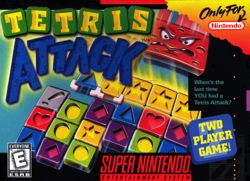 SNES box art 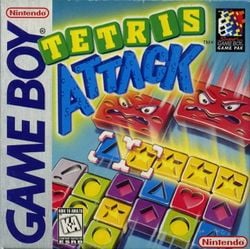 Game Boy box art For alternate box art, see the game's gallery. | |||||
| Developer | Intelligent Systems Nintendo R&D1 (Game Boy version) | ||||
| Publisher | Nintendo | ||||
| Platform(s) | Super Nintendo Entertainment System, Game Boy, Satellaview, Virtual Console (Nintendo 3DS) | ||||
| Release date | SNES/Game Boy: Satellaview: Virtual Console (3DS): | ||||
| Genre | Puzzle | ||||
| Rating(s) |
| ||||
| Mode(s) | Single-player, multiplayer | ||||
| Media | Super NES: Game Boy:
Nintendo 3DS: | ||||
| Input | Super NES: Game Boy:
Nintendo 3DS:
| ||||
Tetris Attack is a Super Nintendo Entertainment System and Game Boy puzzle game featuring the Yoshi franchise as a theme by altering graphics and audio of the Japanese game Panel de Pon. Despite its name, Tetris Attack has no relation to the Tetris series, and follow-ups were named Puzzle League in the west starting with Pokémon Puzzle League. The Japanese version of Tetris Attack was released on the Satellaview as a Yoshi title instead of using the Tetris name license. Like Tetris Attack, there was an option in the menus to play the game with the characters and story dialogue in English, but the menus would stay in Japanese. The Game Boy version was also released in Japan as a standard cartridge.
Gameplay
The title of the game is very misleading in that the gameplay has little to do with Tetris. Instead, square panels rise from the bottom (called the "stack") and the job of the player is to line up three or more matching panels either horizontally or vertically as the stack rises.
The player controls the panels using a rectangular cursor on the screen which the player uses to switch the selected panels back and forth. Extra points are given for combinations of more than three. If the stack touches the top of the playing field while rising, the game is over.
Single-player mode
Endless
In Endless mode, players play to try to achieve the best possible score before they get a game over. Players can choose the difficulty level (Easy, Normal, Hard) and the speed level (lv. 1-99) to start out. However, the longer they manage to stay alive, the faster the stack will start to rise. If the player manages to reach a score of 99,999, the credits sequence will play.
Time Trial
The Time Trial mode is also similar to the Endless mode, except players are given a time limit of two minutes, and the objective is to score as many points as possible before time is up.
Stage Clear
This mode is just like the Endless mode (see above), except players must clear all the panels above the "clear line" that is drawn in the stack. The line is not visible at the beginning of the game, and is only visible when players have cleared enough panels for the stack to rise enough. If the stack touches the top before all the panels above the "clear line" are removed, the players will lose. There is no time limit in this game mode.
There is a total of 30 rounds (not counting the "special stage" and "last stage"), with five rounds per level.
The "special stage" and "last stage" involve defeating Bowser with combos and chains before the stack reaches the very top. While the "special stage" is only a bonus stage to test the players' skills, the "last stage" can be repeated if they lose.
Puzzle
In the puzzle mode, players are given a number of panels on the screen, and they must clear all of them with only a limited number of switches by the cursor. Players play ten rounds with up to six different characters. Also, at the end of each round, players are given a password, which they can use to come back to their game at a later time. There is no time limit for this game mode. There are also some even more difficult puzzles that players can play with if they have the proper password.
VS.
Single player VS. is a game where players can battle the computer in a fight to free the players' allies from a spell cast by Kamek. One by one, the players and Yoshi must break the spell over each of their allies by battling and defeating them. The key to doing that is to dump garbage blocks, which resemble the ceiling from Wario's Woods, on their stack. There are special panels called Shock Panels. When three or more of these align, this creates a Shock Block, a special garbage block, which makes clearing garbage blocks more difficult. Each battle gets successively more difficult, and as the players progress and free their allies, they can use them in battle as well.
Inside Mt. Wickedness, the players will face off against Hookbill the Koopa and Naval Piranha on all the skill levels. On the "Normal" and "Hard" skill levels, Kamek will be the next opponent. And on the "Hard" skill level, the players will face Bowser as the final opponent.
There is also a "Super Hard" skill level, which will heavily test the players' skills. All opponents fought on the "Hard" skill level will be in this skill level.
Characters
While Mario, Luigi, Princess Peach, and Toad do not make a direct appearance in this game, Yoshi fights against Bowser and rescues his friends in the game's single-player versus mode, and he explains the gameplay to the player in the tutorials. A multitude of other characters from Super Mario World 2: Yoshi's Island appear in the game as well, some as allies and some as enemies. The following characters are:
Pals
The following characters can only be used in the VS game modes. There is an exception in the Game Boy version of the Puzzle game mode.
- Bumpty (SNES version only)
- Flying Wiggler
- Lunge Fish
Rivals
Note: All rival characters can only be used in the 2P Mode. There is an exception in the Game Boy version of the Puzzle game mode, however.
Secrets
Below are a list of secrets that can be found. None of them stay unlocked, however.
SNES
- Upon turning on the SNES, press the following buttons;
,
,
,
. If done correctly, the player will hear a chime. When the player does a one-player game mode, the stack will not stop, regardless of if the player does a combo or chain.
- In the 1P VS mode, the player can play the "Super Hard" skill level by pressing D-Pad Up,
, and
at the same time while the "Hard" skill level is selected. If done correctly, the lower background will turn dark red. The dark red background is a sign that the player is playing on the "Super Hard" skill level.
- Players can use the rival characters in the 2P game modes by doing the following; player 1 and player 2 must hold the
and
buttons at the same time while on the character select screen. If done right, the "? panels" will change into the rival characters.
Super Game Boy
When the Game Boy version is played on a Super Game Boy, certain button codes, if "1P" is selected at the title screen, trigger six secret borders, which are based on the background designs used for Yoshi's and his pals' stages in the SNES version. The borders and their corresponding codes are as follows:
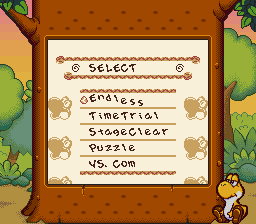 Yoshi stage border |
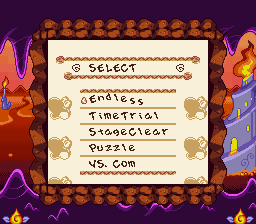 Gargantua Blargg stage border |
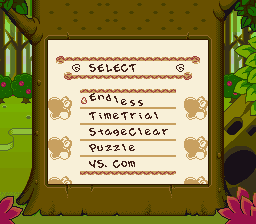 Poochy stage border | |
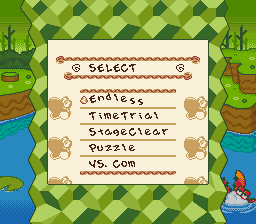 Froggy stage border |
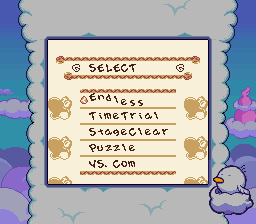 Lakitu stage border |
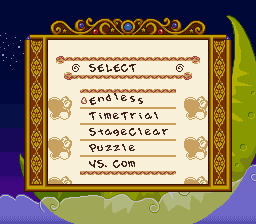 Raphael The Raven stage border |
The player can return to the title screen at any time to choose another border. Pressing just on the title screen will make the border the default star border again, while pressing the
button will keep the current border.
Options
The SNES version of the game does feature an "Options" menu, which enables the player to change the language settings, listen to sound effects and background music, and even view data about the characters.
There is also a "CPU Switch" feature, in which player 1 and/or player 2 will be controlled by a CPU player. However, this feature cannot be used to view game endings in the single player game modes; if attempted, the player will get a message stating that the CPU Switch must be turned off to view the ending.
Panel de Pon
| Panel de Pon | |||
|---|---|---|---|
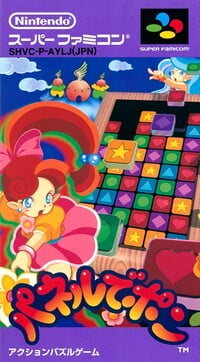 For alternate box art, see the game's gallery. | |||
| Developer | Intelligent Systems | ||
| Publisher | Nintendo | ||
| Platform(s) | Super Famicom, Virtual Console (Wii, Wii U, New Nintendo 3DS), Nintendo Classic Mini: Super Famicom, Super Nintendo Entertainment System - Nintendo Switch Online | ||
| Release date | Super Famicom: Virtual Console (Wii): Virtual Console (Wii U): Virtual Console (New Nintendo 3DS): Nintendo Classic Mini: Super Famicom: Super Nintendo Entertainment System - Nintendo Switch Online: | ||
| Genre | Puzzle | ||
| Rating(s) |
| ||
| Mode(s) | Single-player, multiplayer | ||
| Media | Super NES: Wii: Wii U: Nintendo Switch: Nintendo 3DS: Super NES Classic Edition:
Built-in
| ||
| Input | Super NES: Wii: Wii U: Nintendo Switch: Nintendo 3DS: Super NES Classic Edition:
| ||
Originally, Tetris Attack was Panel de Pon, released for the Super Famicom on October 27, 1995, starring a young fairy known as Lip. However, the game did not initially release in other countries as-is. For the international releases, Nintendo changed all the characters to Yoshi characters and enemies and renamed it.[7]
Differences
Character replacements
| VS. mode stage | Panel de Pon | Tetris Attack |
|---|---|---|
| Start Point | Lip | Yoshi |
| Stage 1 | Windy | Lakitu |
| Stage 2 | Sharbet | Bumpty |
| Stage 3 | Thiana | Poochy |
| Stage 4 | Ruby | Flying Wiggler |
| Stage 5 | Elias | Froggy |
| Stage 6 | Flare | Gargantua Blargg |
| Stage 7 | Neris | Lunge Fish |
| Stage 8 | Seren | Raphael The Raven |
| Stage 9 | Phoenix | Hookbill The Koopa |
| Stage 10 | Dragon | Naval Piranha |
| Stage 11 | Sanatos | Kamek |
| Stage 12 | Corderia | Bowser |
Graphics
- The title sequences are completely different. Panel de Pon has Lip hanging from a dandelion over a field of pink and orange flowers. Tetris Attack has Yoshi sitting on a large flower holding an eggshell with panels in it surrounded by Little Yoshis on smaller flowers, while the background is a jungle area with blue hills similar to the ones seen on the title screen of Super Mario World 2: Yoshi's Island.
- On the main menu in Panel de Pon, Lip is shown sitting on a flower. In Tetris Attack, Yoshi is instead sitting in a floating eggshell, along with Little Yoshi.
- In Panel de Pon, garbage blocks have a different design for each character. In Tetris Attack, all garbage blocks look the same aside from their color; the first player's blocks are blue, while the second player's are red.
- In the character selection screen for 2-player mode, the characters' names shown beneath their icons in Panel de Pon were removed in Tetris Attack due to some of the replacement characters' names being too long to fit there.
- Lip's flower-themed stage was completely redesigned for Yoshi, now taking place on Yoshi's Island. Only the tree that serves as the border for the playing field was left intact, though the leaves are a lighter shade of green and the flowers were removed.
- In Stage Clear, Bowser replaces Sanatos for the "special stage" and "last stage".
- Stage 4 of VS. Mode was changed from a jewel-themed stage (for Ruby) to a flower themed-one (for Flying Wiggler) with graphics resembling tiles seen in certain levels from Super Mario World 2: Yoshi's Island, such as Visit Koopa and Para-Koopa.
- Stages 9, 10, and 11 have unique graphics in Panel de Pon. In Tetris Attack, all three stages use the same background as the cutscenes in Mt. Wickedness.
- Bowser's stage (Stage 12) is an altered version of the Dragon's stage (Stage 10) in Panel de Pon, primarily altering the stone face in the middle to resemble Bowser instead of a dragon.
- The Game Over screens in VS. mode are entirely different. Panel de Pon shows Lip sulking on a plain blue background next to an image of the opponent she lost to, with the words "GAME OVER" in a plain red font inside a speech bubble. Tetris Attack has Yoshi lying dazed on the floor in front of a gradient blue background with the words "GAME OVER" displayed above him in a much larger and more colorful and stylized font.
Audio
- All voice clips were changed to accommodate the character replacements.
- Tetris Attack replaces the title theme from Panel de Pon with an arrangement of the title theme from Super Mario World 2: Yoshi's Island.
- Yoshi's stage theme is an arrangement of the intro story theme from Super Mario World 2: Yoshi's Island, replacing Lip's theme. Lip's theme still plays during the game's tutorials.
- Tetris Attack has victory and loss themes in VS. mode and 2-player mode, while in Panel de Pon, the stage's "panic" theme continues to play even after the match ends. 2-player matches and losses in VS. mode play the same theme that plays at the end of stages in other modes, while victories in VS. mode use a completely new theme.
- Panel de Pon has three Game Over themes, which are music box renditions of Lip's, Windy's, and Elias' themes (the tutorial theme, Lakitu's theme, and Froggy's theme in Tetris Attack). Tetris Attack replaces all of them with a music box rendition of Yoshi's theme.
- Kamek's stage (Stage 11) uses the background music from the Phoenix and Dragon stages, instead of Sanatos' background music, which was moved to Bowser's stage (Stage 12).
- Corderia's background music is not used by any of the playable characters in Tetris Attack, but it does play in the cutscene before the player faces Bowser in VS. mode. This change consequently results in Corderia's "panic" background music to go unused, and was removed altogether.
Miscellaneous
- Tetris Attack added a password system for VS. mode.
- The options menu in Tetris Attack is not selectable through normal means in Panel de Pon, but can be accessed via code devices or hacking.[8]
- After seeing the endings in Panel de Pon, players have to reset the game to return to the title screen. In Tetris Attack, players are taken back to the title screen after the endings are finished.
In the Super Smash Bros. series, Lip's Stick, an item used by Lip, is an item throughout the series. Kirby's Stone move can turn him into many objects, including a garbage block from Panel de Pon. Panel de Pon music also appears in Super Smash Bros. Brawl, Super Smash Bros. for Wii U, and Super Smash Bros. Ultimate. The fairy Lip herself appears as an important character in Captain Rainbow. She also appears as a spirit and Mii Swordfighter costume in Super Smash Bros. Ultimate.
Re-releases
Panel de Pon was released on the Wii's Virtual Console on November 27, 2007[9], on the Wii U's Virtual Console on May 29, 2013, and on the New Nintendo 3DS's Virtual Console on August 9, 2016, once again solely in Japan.[10] It is also one of the 21 games included in the Nintendo Classic Mini: Super Famicom exclusive to Japan.[11] It was also released in Japan and for the first time overseas in the Americas, Europe, and Australia for the Super Nintendo Entertainment System - Nintendo Switch Online application on May 20, 2020.
Names in other languages
| Language | Name | Meaning |
|---|---|---|
| Japanese | パネルでポン Paneru de Pon |
Popping Panel |
| Korean | 패널로 퐁 Paeneollo pong |
Panel Pong |
Development
After the Japanese release of Panel de Pon, Yasuhiro Minagawa, the head of PR at Nintendo of Japan, announced that Rare was requested to release it overseas with the original fairies replaced by Killer Instinct characters and sound effects.[12] This plan for the western localization was ultimately rejected, but the game was later greenlit with a Super Mario theme.[13]
Reception
The game was placed 17th in the 100th issue of Nintendo Power's "100 best Nintendo games of all time" in 1997.[14] Its average score on GameRankings was about 90%[15].
Staff
- Main article: List of Tetris Attack staff
Quotes
- Main article: List of Tetris Attack quotes
Gallery
- For this subject's image gallery, see Gallery:Tetris Attack.
Media
- For a complete list of media for this subject, see List of Tetris Attack media.
| File info |
| File info |
Names in other languages
| Language | Name | Meaning |
|---|---|---|
| Japanese | ヨッシーのパネポン Yosshī no Panepon ヨッシーのパネポンBS版 Yosshī no Panepon BS-ban |
Yoshi's PanePon (Game Boy) Yoshi's PanePon BS Edition (Satellaview) |
Trivia
- In Super Smash Bros. Brawl, there is an error when obtaining the Lip's Stick trophy; it unlocks Tetris Attack in the Chronicle. However, Lip, for whom the weapon is named, does not appear in the game. In the Japanese version, it says Panel de Pon which is where it's from.
- Similarly, this error would continue with the PAL release of Super Smash Bros. for Wii U for the Lip's Stick trophy.
- A minigame from Mario Party 6 and Mario Party DS, called Block Star, resembles the stack of blocks but plays differently.
- In the years following Tetris Attack's release, Henk Rogers of The Tetris Company has stated that he regrets granting Nintendo permission to use the term "Tetris" in the game's title.[16]
References
- ^ Date info of Tetris Attack (SNES) from TMK, retrieved 4/1/2008
- ^ http://www.nintendo.co.kr/Wii/wii/vconsol/penullopong/penullopong_01.php
- ^ Nintendo 公式チャンネル (May 14, 2020). ファミリーコンピュータ & スーパーファミコン Nintendo Switch Online 追加タイトル [2020年5月]. YouTube. Retrieved May 14, 2020.
- ^ Nintendo (May 14, 2020). NES & Super NES - May Game Updates - Nintendo Switch Online. YouTube. Retrieved May 14, 2020.
- ^ @NintendoEurope (May 15, 2020). "More #NES and #SuperNES games will arrive on 20/05 for #NintendoSwitchOnline members!" Twitter. Retrieved May 15, 2020.
- ^ @NintendoAUNZ (May 20, 2020). "More #NES and #SuperNES games have arrived for #NintendoSwitchOnline members!" Twitter. Retrieved May 20, 2020.
- ^ Panel de Pon and Tetris Attack Comparison at The Mushroom Kingdom
- ^ TCRF. Tetris Attack (SNES). The Cutting Room Floor. Retrieved May 3, 2023.
- ^ http://www.nintendo.co.jp/wii/vc/vc_pa/
- ^ http://www.nintendo.co.jp/wiiu/software/vc/ja3j/
- ^ Nintendo. (June 27, 2017). ファミコンに続いて、スーパーファミコンが小さくなって再登場!. Nintendo. Retrieved July 24, 2017.
- ^ Nintendo Magazine System (UK) #40, page 88.
- ^ Nintendo Magazine System (UK) #42, page 8.
- ^ http://www.gamekult.com/communaute/forum/voirmessage.html?foid=13000909, retrieved 6/4/2009
- ^ http://www.gamerankings.com/snes/588787-tetris-attack/index.html
- ^ "Interview with Alexey Pajitnov and Henk Rogers on Tetris"
External links
- Official Website from Nintendo (Panel de Pon)
| Tetris Attack | ||
|---|---|---|
| Pals | Yoshi • Lakitu • Bumpty* • Poochy • Flying Wiggler • Froggy • Gargantua Blargg • Lunge Fish • Raphael The Raven | |
| Rivals | Hookbill The Koopa • Naval Piranha • Kamek • Bowser | |
| Other characters | Mr. Time* • Little Yoshi • Fly Guy • Goonie • Dr. Freezegood • Grinder • Eggo-Dil • Clawdaddy • Flamer Guy • Flopsy Fish • Shy-Guy • Toady | |
| Gameplay | Panel • Garbage block • Shock Panel • Shock Block | |
| Miscellaneous | Gallery • Media • Quotes • Staff | |
| * Exclusive to the SNES version. | ||
| Game Boy games | |
|---|---|
| Super Mario franchise | Alleyway (1989) • Baseball (1989) • Super Mario Land (1989) • Golf (1989) • Dr. Mario (1990) • Super Mario Land 2: 6 Golden Coins (1992) • Donkey Kong (1994) • Mario's Picross (1995) • Picross 2 (1996) |
| Donkey Kong franchise | Donkey Kong (1994) • Donkey Kong Land (1995) • Donkey Kong Land 2 (1996) • Donkey Kong Land III (1997) |
| Yoshi franchise | Yoshi (1991) • Yoshi's Cookie (1992) • Tetris Attack (1996) |
| Wario franchise | Wario Land: Super Mario Land 3 (1994) • Wario Blast: Featuring Bomberman! (1994) • Wario Land II (1998) |
| Miscellaneous | Tetris (1989) • The Legend of Zelda: Link's Awakening (1993) • Game & Watch Gallery (1997) • Game & Watch Gallery 2 (1997) |
